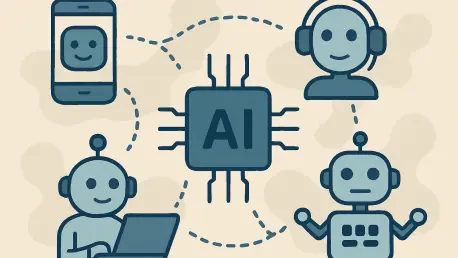Imagine a scenario where a critical system outage halts operations across multiple cloud regions, and teams scramble to coordinate disparate AI tools to detect, analyze, and resolve the issue, leading to significant challenges. Each tool operates in isolation, resulting in delays, miscommunication, and inefficiencies that cost valuable time and resources. This chaos reflects a broader challenge in today’s tech-driven landscape: managing an ever-growing array of specialized AI agents that lack unity. The purpose of this guide is to equip readers with the knowledge and tools to orchestrate these fragmented AI agents into a cohesive, efficient workflow system. By mastering agent orchestration, the goal of seamless collaboration and enhanced productivity becomes achievable.
The significance of this guide lies in its ability to address the operational silos that hinder organizations as AI adoption accelerates, especially with specialized tools multiplying across vendors and environments. The complexity of manual coordination often results in bottlenecks and missed opportunities, making effective management crucial. Agent orchestration offers a transformative solution, akin to a conductor guiding an orchestra, ensuring each instrument plays in harmony. This how-to guide provides a structured approach to unify AI agents, streamline complex processes, and unlock their collective potential for maximum impact.
This resource is designed for professionals seeking to eliminate manual handoffs and scale operations effortlessly. It breaks down the intricate process of orchestration into actionable steps, from planning to continuous optimization, while highlighting real-world applications and emerging challenges. By following the detailed framework presented, the aim is to empower readers to build intelligent, adaptive systems that drive efficiency across diverse industries. The journey toward workflow transformation begins with understanding the power of coordination.
Unveiling the Power of AI Agent Orchestration
The rapid proliferation of AI tools has introduced a new layer of complexity in managing workflows across varied platforms and vendors. Organizations often deploy multiple specialized agents, each designed for specific tasks, but these tools frequently operate in isolated environments. Such operational silos create inefficiencies, as data and context fail to flow seamlessly between systems, resulting in duplicated efforts and delayed outcomes. The central challenge emerges as a pressing concern: how can these fragmented tools be unified into a single, effective system?
Agent orchestration stands as the solution to this dilemma, acting as a central coordinator that integrates disparate AI agents into a harmonious workflow. Much like a senior engineer directing a team by assigning tasks based on expertise, an orchestrator ensures that each agent contributes to shared objectives with precision. This approach not only bridges gaps between tools but also fosters collaboration with third-party systems, enabling the resolution of intricate problems through synchronized efforts.
The transformative potential of orchestration cannot be overstated, as it paves the way for streamlined processes and significant productivity gains. By facilitating coordination, businesses can reduce manual interventions, minimize errors, and accelerate decision-making. Key benefits include the ability to manage complexity with ease and the promise of turning isolated tools into a powerful, unified force. This sets the foundation for a deeper exploration of how orchestration can reshape operational efficiency.
The Evolution of AI Tools and the Need for Coordination
Tracing the development of AI tools reveals a shift from standalone, general-purpose solutions to a landscape dominated by highly specialized agents. In earlier stages, single AI systems were often sufficient for basic tasks, but as industries embraced digital transformation, the demand for tailored capabilities grew. This evolution led to a surge in niche tools designed for specific functions, each excelling in its domain but lacking the ability to interact with others effectively.
Today, the rapid adoption of AI across sectors like healthcare, finance, and technology has amplified the challenge of managing these siloed agents, creating significant hurdles for organizations. Without interoperability, organizations face operational bottlenecks, where critical data remains trapped within individual tools, hindering comprehensive analysis and response. The absence of a unified approach often results in fragmented workflows, making it difficult to tackle complex, multi-step problems that require collaboration among various systems.
Orchestration emerges as a vital strategy to address this growing complexity and unlock the collective strength of AI agents. By enabling seamless communication and task delegation, it ensures that specialized tools work toward common goals rather than in isolation. Moreover, orchestration facilitates integration with external systems, allowing for sophisticated problem-solving and decision-making that can adapt to dynamic environments. This need for coordination marks a pivotal moment in harnessing AI’s full potential.
Building Blocks of an Effective AI Orchestration Framework
Creating a robust orchestration framework requires a focus on foundational elements that ensure seamless coordination among AI agents, providing the structure needed to manage diverse tools and align their efforts toward efficient outcomes. The following components and strategies lay the groundwork for a system that can handle complex workflows with precision and adaptability.
Each element of the framework serves a distinct purpose, from managing task dependencies to ensuring data consistency across operations. By understanding and implementing these pillars, organizations can overcome the limitations of siloed tools and build a cohesive environment. This section explores the critical aspects that contribute to successful orchestration, offering actionable insights for implementation.
Establishing Contextual Workflow Orchestration
Contextual workflow orchestration lies at the heart of coordinating AI agents, ensuring that tasks are executed in the correct sequence with proper dependencies in place. An orchestrator acts as a central manager, directing the flow of activities and ensuring that each agent receives the necessary inputs to perform its role. This approach prevents disruptions and maintains a logical progression through multi-step processes.
Ensuring Seamless Task Progression
A key aspect of workflow orchestration is the seamless handoff of contextually relevant outputs between agents. When one agent completes a task, the orchestrator ensures that the resulting data or insights are passed to the next agent in a format that preserves meaning and utility. This continuity is essential for maintaining efficiency, as it minimizes the need for rework and keeps the workflow moving forward without unnecessary interruptions.
Creating Intelligent Data Pipelines for Agents
Data flow forms the backbone of any orchestrated system, enabling agents to access shared resources and collaborate effectively. Intelligent data pipelines ensure that information moves seamlessly between tools, eliminating barriers that could disrupt operations. By centralizing data access, the orchestrator allows agents to operate on consistent datasets, fostering accuracy and coherence across tasks.
Facilitating Data Consistency Across Operations
To prevent fragmentation, methods must be in place to facilitate information exchange among agents. This includes establishing protocols for real-time updates and ensuring that all agents work from the same data source when necessary. Such consistency reduces discrepancies and errors, enabling a unified approach to problem-solving and ensuring that insights generated by one agent can be leveraged by others without conflict.
Leveraging Open-Source Orchestration Technologies
Open-source technologies offer a valuable resource for building scalable and interoperable orchestration systems. These frameworks provide accessible tools and standardized protocols that simplify the coordination of AI agents across diverse environments. By adopting such solutions, organizations can benefit from community-driven innovation and avoid the constraints of proprietary systems.
Harnessing Standardized Protocols for Communication
Specific protocols, such as Google’s A2A (Agent-to-Agent) communication framework, exemplify how standardized approaches can enhance interaction and monitoring. These protocols define clear rules for data exchange and task delegation, ensuring that agents communicate effectively regardless of their origin or vendor. This interoperability is crucial for creating a cohesive system that can scale with evolving needs.
Defining Key Architectural Components of Orchestrators
The architecture of an orchestrator includes several critical components that work together to manage workflows, ensuring efficient operation across various tasks and interactions. These include the central orchestrator itself, which oversees interactions; the classifier, which evaluates and assigns tasks; the agents performing specific functions; conversation storage for maintaining history; and retrievers for accessing external context. Each plays a pivotal role in ensuring smooth operation.
Optimizing Agent Selection with Classifiers
Classifiers are instrumental in matching tasks to the most suitable agents based on their capabilities and past performance. By analyzing historical data and agent characteristics, classifiers ensure that assignments are both efficient and effective. This targeted selection process optimizes resource use, reduces execution time, and enhances the overall quality of outcomes within the orchestrated system.
Core Steps in the AI Agent Orchestration Process
Implementing AI agent orchestration requires a structured approach to ensure that workflows are efficient and adaptable, and it is crucial to follow a clear plan to achieve optimal results. The following steps provide a comprehensive roadmap for coordinating specialized agents, guiding users through each phase of the process. By adhering to this framework, the complexity of managing multiple tools can be transformed into a streamlined operation.
This detailed process covers everything from initial planning to continuous improvement, addressing the nuances of integrating diverse systems. Each step builds on the previous one, creating a logical progression toward a fully orchestrated environment. The focus remains on practical application, ensuring that theoretical concepts translate into tangible results.
Step 1: Assessment and Strategic Planning
The first step involves a thorough evaluation of existing workflows to identify specific needs and define orchestration goals, ensuring that the process is aligned with organizational priorities from the start. This assessment requires mapping out current processes, pinpointing inefficiencies, and determining where AI agents can add value. A clear understanding of objectives sets the direction for the entire orchestration effort.
Identifying Critical Workflow Gaps
Drilling deeper, it’s essential to spot critical gaps where manual intervention or lack of coordination causes delays, which can significantly impact overall efficiency. This might include areas where data isn’t shared effectively or where tasks are redundantly handled by multiple tools. Highlighting these inefficiencies helps in crafting a targeted strategy that addresses pain points and lays the foundation for agent integration.
Step 2: Selection of Specialized AI Agents
Once needs are identified, the next step focuses on choosing agents with the right skills for specific workflow components, ensuring that the selection process is thorough and effective. This process involves evaluating the strengths and limitations of available tools, ensuring they align with the tasks at hand. A well-chosen set of agents forms the core of an effective orchestration system.
Matching Agent Capabilities to Tasks
To achieve optimal results, agent expertise must be carefully matched to workflow requirements. For instance, an agent designed for log analysis should handle diagnostic tasks, while another suited for automation manages deployment. This deliberate alignment ensures that each agent operates within its area of strength, contributing to overall efficiency.
Step 3: Implementing the Orchestration Framework
With agents selected, the focus shifts to setting up the orchestration system, integrating all components for smooth operation. This step involves configuring the central orchestrator, establishing data pipelines, and ensuring that all elements communicate effectively. A robust setup is critical for avoiding disruptions during execution.
Configuring Robust Communication Channels
Reliable protocols for agent-to-agent interaction must be established to support seamless task handoffs. These channels ensure that data and instructions are transmitted without loss or delay, maintaining the integrity of the workflow. Proper configuration at this stage prevents future bottlenecks and supports scalability as needs evolve.
Step 4: Dynamic Agent Assignment in Real Time
Orchestration systems must adapt to real-time conditions by dynamically routing tasks based on agent availability and current demands. This flexibility allows the orchestrator to respond to unexpected changes, ensuring that workflows remain uninterrupted. Dynamic assignment is a hallmark of an intelligent, responsive system.
Adapting to Evolving Workflow Demands
Mechanisms for flexible task delegation are vital during execution, as priorities or conditions may shift, requiring quick adjustments to maintain efficiency. The orchestrator must be equipped to reassess and reassign tasks on the fly, balancing workloads and optimizing performance. Such adaptability ensures that the system remains effective even under varying circumstances.
Step 5: Workflow Coordination and Execution
Active management of workflows comes next, with the orchestrator overseeing task progression across agents. This step ensures that each stage of the process is completed in sequence, with dependencies respected and outcomes monitored. Effective coordination at this point translates into tangible workflow improvements.
Minimizing Delays in Task Handoffs
To reduce bottlenecks, strategies must be implemented to streamline transitions between agents. This includes predefining handoff protocols and ensuring that outputs are formatted for immediate use by the next agent. Minimizing delays keeps the workflow on track and maximizes operational efficiency.
Step 6: Intelligent Data Sharing and Context Management
Maintaining consistent data and context across agents is crucial for avoiding errors and ensuring coherence in operations. This step focuses on enabling shared access to information, allowing each agent to build on the work of others effectively. Proper data management underpins the success of the entire orchestration process.
Overcoming Token Limits and Memory Fragmentation
Challenges such as token limits and fragmented memory can disrupt context retention in complex workflows, making it difficult to maintain a seamless flow of information. Solutions involve implementing storage mechanisms that preserve state and using compression techniques to manage data constraints. Addressing these issues ensures that agents operate with a complete understanding of prior actions.
Step 7: Adaptive Optimization and Continuous Learning
The final step emphasizes refining orchestration through feedback and performance analysis. By evaluating outcomes and identifying areas for improvement, the system can evolve over time. Continuous learning ensures that orchestration remains relevant and effective as new challenges arise.
Incorporating Insights for Ongoing Improvement
Leveraging data from past cycles allows for ongoing enhancement of the orchestration process. Insights gained from performance metrics can inform adjustments to task assignments, data flows, or agent selection. This iterative approach drives sustained progress and keeps the system aligned with changing needs.
Real-World Impact: Use Cases of AI Agent Orchestration
Agent orchestration delivers measurable value in practical scenarios, addressing complex challenges across various domains. These use cases illustrate how coordinated AI systems can transform operations by automating responses and ensuring seamless collaboration. Each example highlights the orchestrator’s role in unifying disparate tools for impactful results.
In autonomous incident coordination, orchestration automates responses to service disruptions, such as a breach in service level objectives, ensuring swift and efficient handling of issues. The system coordinates a monitoring agent to detect anomalies, an analysis agent to review logs and metrics, and an automation agent to apply fixes, all without human intervention. This rapid, unified response minimizes downtime and maintains service reliability.
Another application is multi-cloud disaster recovery, where an orchestrator manages failover strategies during outages. It directs a health monitoring agent to identify failures, a verification agent to confirm data integrity, a routing agent to redirect traffic, and a notification agent to alert stakeholders. This seamless execution across cloud providers ensures business continuity under critical conditions. Additionally, in API deployment and monitoring, orchestration streamlines developer requests by coordinating deployment, monitoring, and anomaly detection agents, ensuring smooth updates and quick issue resolution.
Navigating Challenges and Future Trends in Agent Orchestration
While the benefits of agent orchestration are substantial, implementation comes with notable challenges that must be addressed to ensure success. Complex coordination across multiple agents increases the risk of errors and system failures, requiring meticulous planning and robust error-handling mechanisms. High costs associated with compute resources and integration efforts can also obscure the return on investment, demanding careful budgeting and prioritization.
Context management poses another hurdle, as maintaining a consistent state across agents is often complicated by token limits and fragmented memory, creating significant challenges in ensuring smooth operation. Security risks further compound the issue, with inter-agent communication and API exposure expanding the potential attack surface and raising privacy concerns. Addressing these obstacles requires innovative solutions, such as advanced encryption and streamlined data retention strategies, to safeguard operations.
Looking ahead, emerging trends in agent-based architectures point to a growing reliance on orchestration for scaling AI capabilities. The development of enhanced open-source frameworks promises greater accessibility and customization, while improved security protocols aim to mitigate risks. These advancements suggest a future where orchestration becomes even more integral to managing AI complexity, offering organizations the tools to stay competitive in an evolving landscape.
Embracing AI Orchestration for Transformative Efficiency
Reflecting on the journey through agent orchestration, the steps taken—from initial assessment to adaptive optimization—laid a solid foundation for transforming fragmented AI tools into unified systems. Each phase, whether it was selecting specialized agents or ensuring seamless data sharing, contributed to eliminating inefficiencies that once plagued workflows. The process proved that coordination was not just a technical necessity but a strategic advantage.
Moving forward, the focus should shift to exploring advanced orchestration frameworks that can further refine these systems, ensuring they operate at peak efficiency. Integrating emerging agents with cutting-edge capabilities and staying abreast of open-source innovations offers a pathway to sustained improvement. Experimentation with new protocols and security measures also emerges as a priority to address lingering challenges.
As a final consideration, building a culture of continuous learning within teams has become essential to keep pace with AI advancements. By fostering adaptability and encouraging the adoption of orchestration best practices, the groundwork is set for long-term success. These actionable steps ensure that the efficiency gains achieved through orchestration are not just a milestone but a stepping stone to even greater operational excellence.









